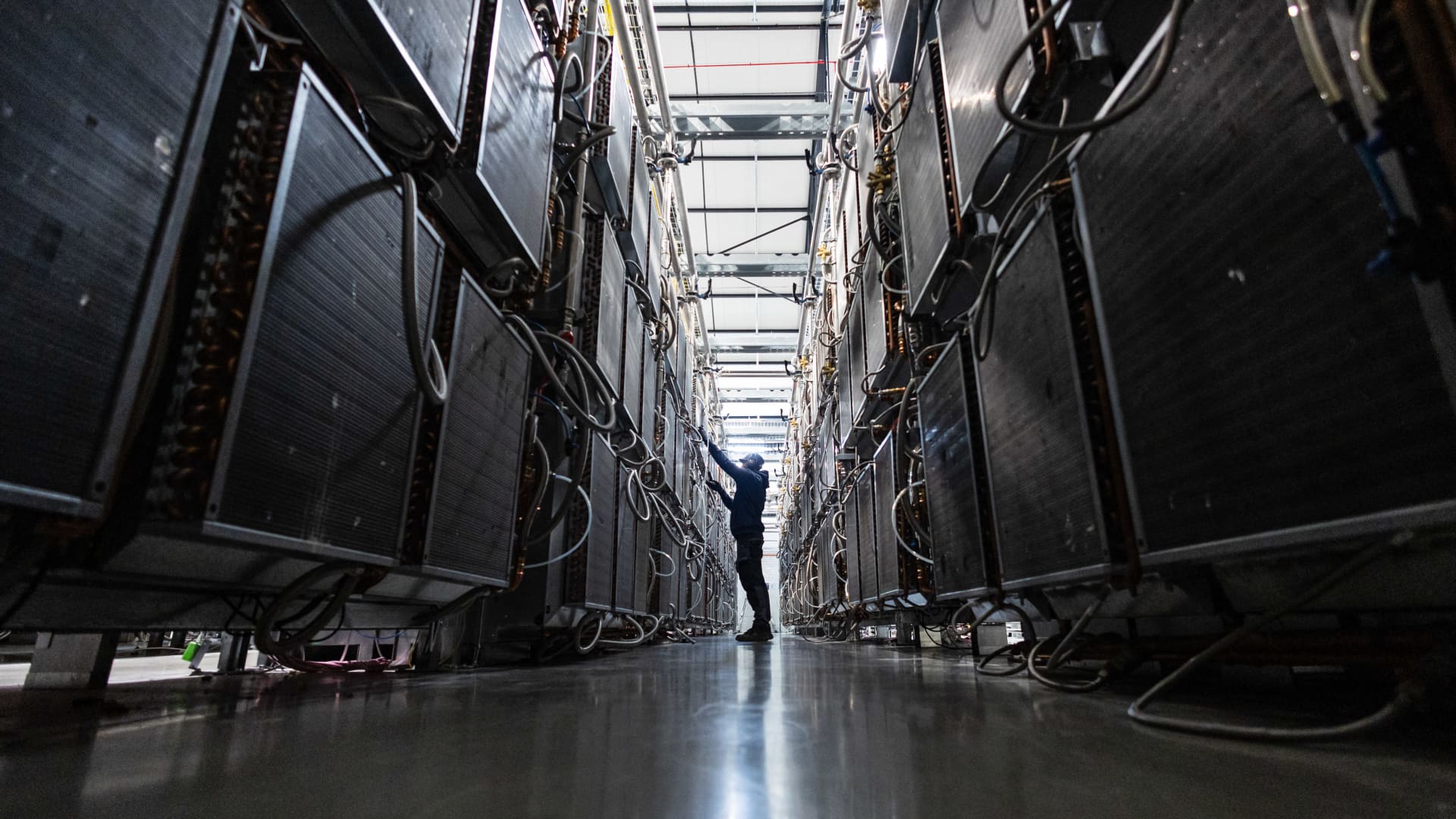Europe, with its fragmented markets, is often said to be operating in the shadow of the U.S. and China when it comes to scaling AI.
But the very factors that challenge its growth as a major player may yet give it an edge when it comes to future-proofing the critical warehouses that power the AI boom.
The world is racing to double, if not triple, the entire data center capacity that has been built over the last forty years, Pankaj Sachdeva told CNBC, McKinsey senior partner in technology, with McKinsey estimating that build-out will cost up to $7 trillion by 2030.
He expects the U.S. to account for the lion’s share of activity, but Europe will “continue to build at a pretty meaningful rate” to nearly double its existing capacity.
“Europe is actually participating in this infrastructure build out, and is actually keeping pace, or we think that it will keep pace,” Sachdeva added.
To get there, the bloc must overcome major chokeholds in access to power and regulation, experts told CNBC.
Winners and losers
The defining bottleneck for Europe is access to electricity, with energy cost and availability shaping the flow of investment across the region. The Nordics and Spain have seen increased appetite for data center builds given their surplus in energy thanks to hydropower and renewables, while Germany and the U.K. may be less attractive due to energy supply constraints.
In terms of grid congestion, Italy is one such country on the winning side. It has a connection time of up to three years compared with the European average of four years, according to energy think tank Ember.
On the losing side is again Germany, the U.K., Ireland and the Netherlands, “where, basically either we just don’t have the grid capacity right now or we’ve got such a shortage in the system that there’s effectively a moratorium for the foreseeable future,” Jags Walia, head of global listed infrastructure at Van Lanschot Kempen told CNBC.
While differences between European countries are significant, it’s ultimately “going to be hard” to catch up on the U.S. in the short-term — where deregulation and huge investment are enabling a much quicker build-out — Walia said. Most European countries have around 200 to 300 data centers, he added, but “the U.S. has like 5,400.”
Constraints are resulting in some a diversification away from the traditional FLAP-D markets of Frankfurt, London, Amsterdam, Paris, and Dublin, and driving investment in data centers where resources are plentiful and stable.
Where Europe, from my perspective, stands out as quite interesting is it feels like a much more safer investment case
Seb Dooley
Senior Fund Manager at Principal Asset Management
There have also been some efforts to develop projects faster. For example, in the U.K., there have been instances of central government overruling local government to approve data centers that were previously denied. Last year the country designated data centers Critical National Infrastructure, highlighting their important in its economic agenda.
A powerful bottleneck
Energy consumption from power-hungry data centers could more than double to 1,000 terawatt-hours (TWh) in 2026, up from 460 TWh in 2022 and largely driven by AI, per the International Energy Agency.
A data center’s largest cost component is electricity, though newer, state-of-the-art facilities could have a reduced burden, according to Walia.
This is a particularly sticky problem for Europe, which saw its energy bills skyrocket when Russia invaded Ukraine. The U.K. has the highest energy costs in Europe, which are around 75% higher than before the full-scale attack.
While this can be a deterrent for setting up shop in a particular location, operators aim to balance it with grid congestion times.
Grid congestion has also instigated discussions about how to procure power in Europe, according to CBRE’s European data center research lead Kevin Restivo.
“You get a lot of speculators in the queue, and those speculators make it more difficult because they have no intention of building data centers. They just want the power, perhaps, to flip it somebody else,” Restivo told CNBC.

The U.K., for example, operated on a first-come-first-served basis, meaning project significance was not factored into the decision of who receives power first.
However, the system is currently being transitioned to a ‘first ready, first connected,’ process where finished projects will be able to jump ahead in the connection queue, which were designed in part to tackle speculation. The reforms show how energy and infrastructure builds are forcing old systems to evolve and sets the stage for further innovation.
At the same time, the steady pace of change allows developers to be more deliberate about what they build, where, and how — meaning Europe could put greater emphasis on state-of-the-art facilities.
The quickest way for Europe to get around these challenges is not to wait on new grid connection but to say ‘where do I currently have good grid connection to an industry in decline?’, Walia said, as such sites can be repurposed from industrial to tech hubs.
The opportunity in AI inference
It’s unlikely that Europe will lead in building facilities for AI hyperscalers or for the training of AI — that race is considered all but won — but the general consensus is that it could excel in smaller, cloud-focused and connectivity-style facilities that require huge amounts of fiber going in and out of them, as well those designed for AI inference.
Indeed, the continent has few foundational model developers, with France’s Mistral being the most well-known, but McKinsey sees 70% of all AI demand coming from inference.
As such, the continent isn’t seeing “too many” massive data center sites being announced relating to AI, nor “the slightly overpriced nature” of them, according to Seb Dooley, senior fund manager at Principal Asset Management.
“So, actually, you are finding these areas, from our perspective, are well protected from that potential oversupply bubble that could come through,” he added, as cloud is well established.
It is largely driven by AI, but non-AI workloads are also expected to tick upwards
Principal Asset Management expects AI inference to take place in the same facilities as cloud, which has already happened at some of its U.S. cloud sites. This gives investors “quite a nice upside” without the speculative risk that comes with other AI investments, the fund manager said.
It’s also an opportunity for Europe. Inference likely will have to exist within European borders, Dooley said, driven by the broader push for sovereign AI. However, it has different technical requirements; density tends to be higher than the 20 kilowatts a rack for traditional cloud, meaning data centers that want to do both must factor that in. Inference also requires different cooling systems.
“That just means that you have to design these facilities to be sort of flexible and robust so that you can change between the two different systems as requirements change, Dooley added.
The joy of a slower and more considered pace in Europe, therefore, is that there is time to think about such things.
The risk of stranded assets
The pace of AI development has led to widespread chatter of a bubble, which would result in piles of stranded assets if it were to pop. If AI keeps its cadence, which many believe it will, there is still a risk that data centers built today won’t be suitable in the future as AI’s technical needs will change.
To help, investors are focusing on securing customers before ground is broken. Speculative-built data centers are “a relic of the past, for the most part,” said Restivo. Developer-operators often lock customers into 10-to-15-year terms, he added, which also couches obsolescence.
It’s a different case, however, if the tenant themselves is a startup or young company. Neo-cloud providers, for example, carry “significant risk” and have shorter terms of five-to-seven years, Restivo said.

“These are companies that have not returned capital to shareholders, they have unproven business models, and they have a great need for capacity in a shorter period of time,” he said, adding that there is “a lot of skin in the game for developer-operators” working with neo-clouds. However, some debt financiers and developers are “increasingly comfortable” with these terms, Restivo added.
There may be issues with repurposing brownfield sites, however, is if data centers are replacing an industrial plant that’s still running – meaning job losses. European policy requires developers to report energy and water usage of data centers, as well as justification for the particular location.
Some member states go further. Walia pointed to proposed sustainability requirements in Spain, which would see data center developers report socio-economic impact. “Nobody asks about that in the U.S.,” he said.
But Dooley expects that tight regulations will work in Europe’s favor in the long-run, as data centers will be integrated into local communities “rather than just being a complete blight on everyone’s life that they can sometimes be,” he said, noting that sustainability is one area where the bloc has been “very good at innovating.”
“Where Europe, from my perspective, stands out as quite interesting is it feels like a much more safer investment case if we’re looking more from the capital market side compared to the U.S.,” Dooley said.
“A lot of that comes from the fact that it’s difficult to build in Europe. We’ve got a lot of constraints, but, actually, the more difficult something is to replicate, the more long-term value what you’ve got has, the more likely people are to reuse, to come up with creative solutions to repurpose assets,” he added.
Ultimately, investors and developers may have no choice in the matter but to back Europe thanks to sovereign AI — an “underestimated” driver of the data center build, Jim Wright, manager of the Premier Miton Global Infrastructure Income Fund, told CNBC.
In all, Europe has the opportunity to innovate and create long-term value for both investors and citizens. Scarcity increases profitability and resilience for the former, while regulation encourages sustainable and constructive build outs for the latter.
However, there is not going to be a one-size-fits-all approach to building data centers in Europe. “The industry is still very much in ‘figuring out what exactly it needs’ phase at the moment,” Dooley added.





